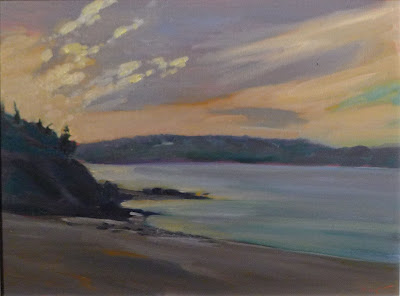What causes the droughts in our creative life, when we’ve apparently forgotten everything we ever knew about painting?
| Ottawa House, oil on canvas, Carol L. Douglas, available. |
I’m back in Nova Scotia for a two-week residency at Parrsboro Creative. A few years ago, they decided their little community at the top of the Bay of Fundy ought to be a major art center. A series of artist residencies is part of their master plan.
One of my goals is to paint some of the scenes I haven’t gotten to during three years at Parrsboro International Plein Air Festival (PIPAF). The first of these is historic Ottawa House. Built around 1770, it became the summer home of Sir Charles Tupper in 1871. Tupper was a well-known politician who once served as Prime Minister of Canada for 69 days.
The only way to paint the scene is to set up along a hairpin turn. The right side of the road is a blind spot for drivers whipping around the bend, so I faced oncoming traffic.
 |
| My home-away-from-home for the next two weeks. |
A local stopped. “Two weeks ago, two girls lost control on this corner and plowed into the guardrail there.” He pointed to a spot about thirty feet away. “If it weren’t for these cables, they’d have gone over the embankment. Took two posts clean out.”
I began to think about Grant Wood’s Death on the Ridge Road. “Those cables have been there since the Second World War,” said the man, patting a post fondly. They certainly have the whiff of age about them, and are battered and twisted from impacts across the years.
I’m starting to know people in Parrsboro, and one of them stopped to chat as I worked. “You’ve chosen a dangerous spot,” he started.
That was my clue to move along. The affair was starting to remind me of that joke that ends with God saying, “First I sent you a canoe, then a boat, and then a helicopter. What more did you want?”
 |
| Four Ducks, oil on canvas, Carol L. Douglas, sold. |
Sandwiched between my visits to Nova Scotia was Cape Elizabeth Land Trust’s 12thAnnual Paint for Preservation. I wrote last week about the disparity in pricing and awards for women artists, and how Parrsboro Creative was turning the tide. That trend continued at Cape Elizabeth, where the top price was earned by Jill Hoy.
Still, all except two of the top 20% were men. I was the other woman. While I’m pleased, I also want to see my paint-spattered sisters consistently getting their due.
I’ve spent the better part of a week pondering why I painted so well at Cape Elizabeth and so badly at PIPAF the prior week. Robert More reminded me that the creative space is elusive, showing up where and when it wants. I was certainly tired and rushed when I arrived in Parrsboro.
Despite my workmanlike approach to painting, there are times when it all goes bad. The advantage to being older is that you’ve gone through this many times before, and you know it’s a transient problem. “You can’t create when the well runs dry,” my friend Jane Bartlett says. Prayerful reflection, sleep, reading and recreation all refill the well. I’ve done those things, and I’m back on track. Let’s hope it continues.





